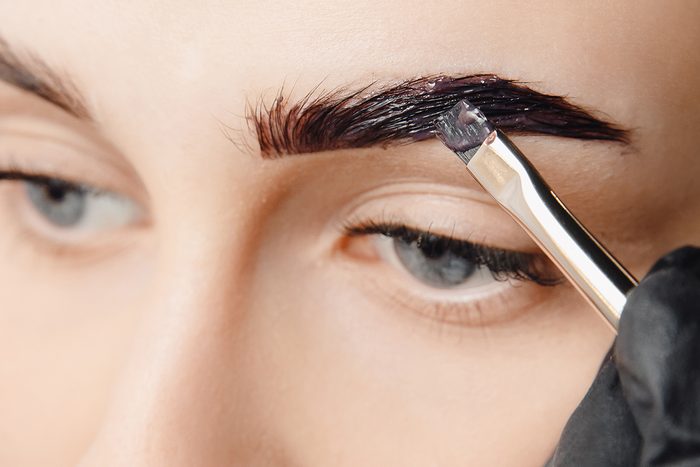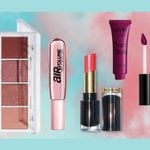Henna Brows: The New Trend that Uses One of the Oldest Hair Dyes

Should you try henna brows? Here’s what the pros say.
In the past few years, we’ve witnessed the birth of microblading (in which eyebrow hairs are tattooed onto skin), ombré brows (which involves dots being tattooed on skin for a faded look) and brow lamination (where brows are permed up for a feathery look). Now, a new service, using one of the world’s oldest hair dyes, is popping up on beauty salon menus across the country. ”Henna brows” is the latest way to tint eyebrows and get the perfect shape and look.
Traditional eyebrow tinting dyes only the hair, but with henna brows, the skin is tinted as well, says Krishna Patel, senior brow artist at Kereshmah Beauty in Toronto. “This means we’re able to transform the shape of the eyebrows, and even make them appear thicker.” The treatment uses henna paste mixed with dye, explains Krishna, so it doesn’t turn brows the orangey-red shade of henna, and can be used on hair of all shades, from black to blonde.
Intrigued? Here’s everything you need to know about henna brows.
(Related: Brows 101—How To Build a Perfect Brow)
What is henna?
Henna, also known as mehndi, is a dye derived from a plant (called Lawsonia inermis), and it can also refer to temporary intricate body art typically painted on women’s hands in some cultures for special ceremonies and celebrations. It’s commonly used in South Asian countries, particularly India and Pakistan, but the origins go back to Egypt, says Divya Patel, a professional henna artist (who has no relation to Krishna Patel).
“Back in the day, henna was used for its cooling property,” says Divya. “People used to apply henna to the soles of their feet and other parts of their bodies in hotter climates to cool their bodies.” After noticing the dying effect, women began using henna as makeup—on nails for natural polish, lips for a natural lipstick, hair for natural hair dye. Most recently, it’s been used to create temporary freckles, and now, dye eyebrows.
What is henna paste made out of?
There are different ways to make henna paste, also known as Mehndi paste. The traditional way, explains Divya, starts with drying and crushing leaves from the henna tree into a powder, and mixing it with water, lemon juice, tea and essential oils.
“Ready-made henna [which is offered at many salons] is not natural, even if [salons] advertise it as natural, because henna does not have shelf life,” says Divya. “A lot of over-the-counter henna have added chemicals, but I don’t necessarily think those chemicals are dangerous.” The one thing to avoid, according to both Divya and Krishna, is black henna. “It contains a chemical called para-phenylenediamine (PPD), which is very dangerous and can cause allergic reactions,” says Krishna.
How are henna brows done?
According to Krishna, the henna brows process starts with a consultation so the aesthetician understands the shape the client wants. Then the brows are cleansed to remove oil and dirt so the dye will better adhere to the skin and hairs.
Next, the dye is applied, ideally in an ombré technique to avoid a boxy brow look and achieve more natural results. “I remove the tint in the inner corners of the brows within the first two minutes and leave the dye on the rest of the brows for a few more minutes,” says Krishna. Once the dye is removed, brows are waxed, plucked or threaded into shape, and trimmed. The whole process takes about 45 minutes and costs upwards of $50.
How long does it last?
On average, it lasts about three weeks, says Krishna. But if your skin is oily or combination, or if you are really active and therefore sweat a lot, it may last only one or two weeks. To ensure henna brows last as long as possible, Krishna advises to keep skin products, like cleansers and creams, away from the eyebrow area.
When did henna brows gain popularity in Canada?
Henna brows slowly started popping up on Canadian salon menus in 2019, says Darya Maleki, owner of Kereshmah Beauty. “Before then, henna brows were done at very few salons around the world,” she says. And now, Darya says the treatment is more popular at her Toronto salon than typical brow tinting. “Even if someone books a brow tint I try to convince them to do henna brows because it lasts longer and can transform the shape better than just the brow tint,” adds Krishna.
Are there any risks to henna brows?
“My only advice is just to take the safest route possible,” says Divya. “I’ve seen a lot of people use henna to do freckles using chemicals from Amazon, and that’s not the safest way to do it.”
Krishna does patch tests on clients before applying henna. “I add a touch of the dye to the wrist, and tell them to look for a reaction within the next 24 hours, but we’ve never had any issues before.” She advises avoiding henna brows if you’re pregnant—even though henna is generally safe for pregnant women, the dye that’s added to the henna paste for henna brows may cause a reaction.




